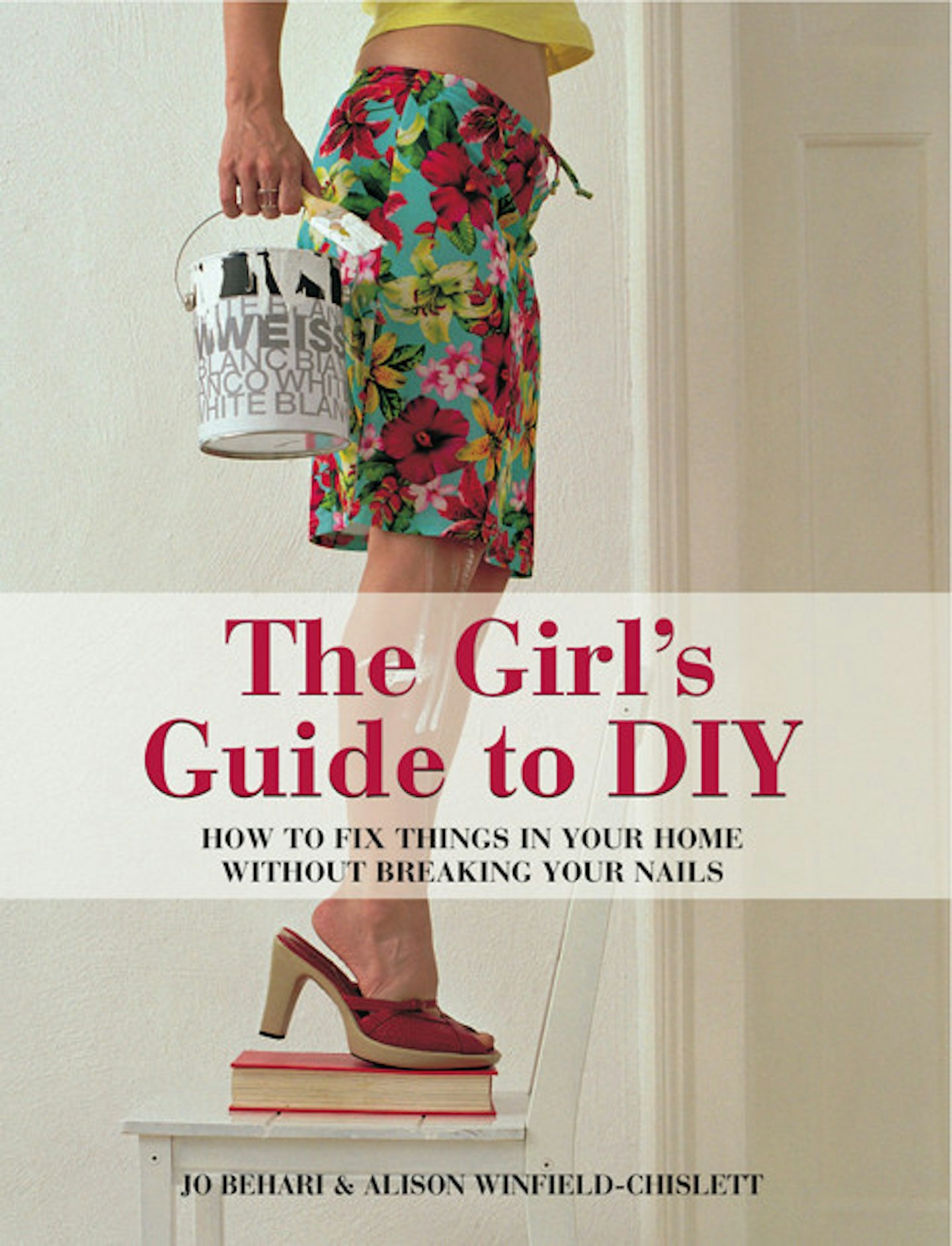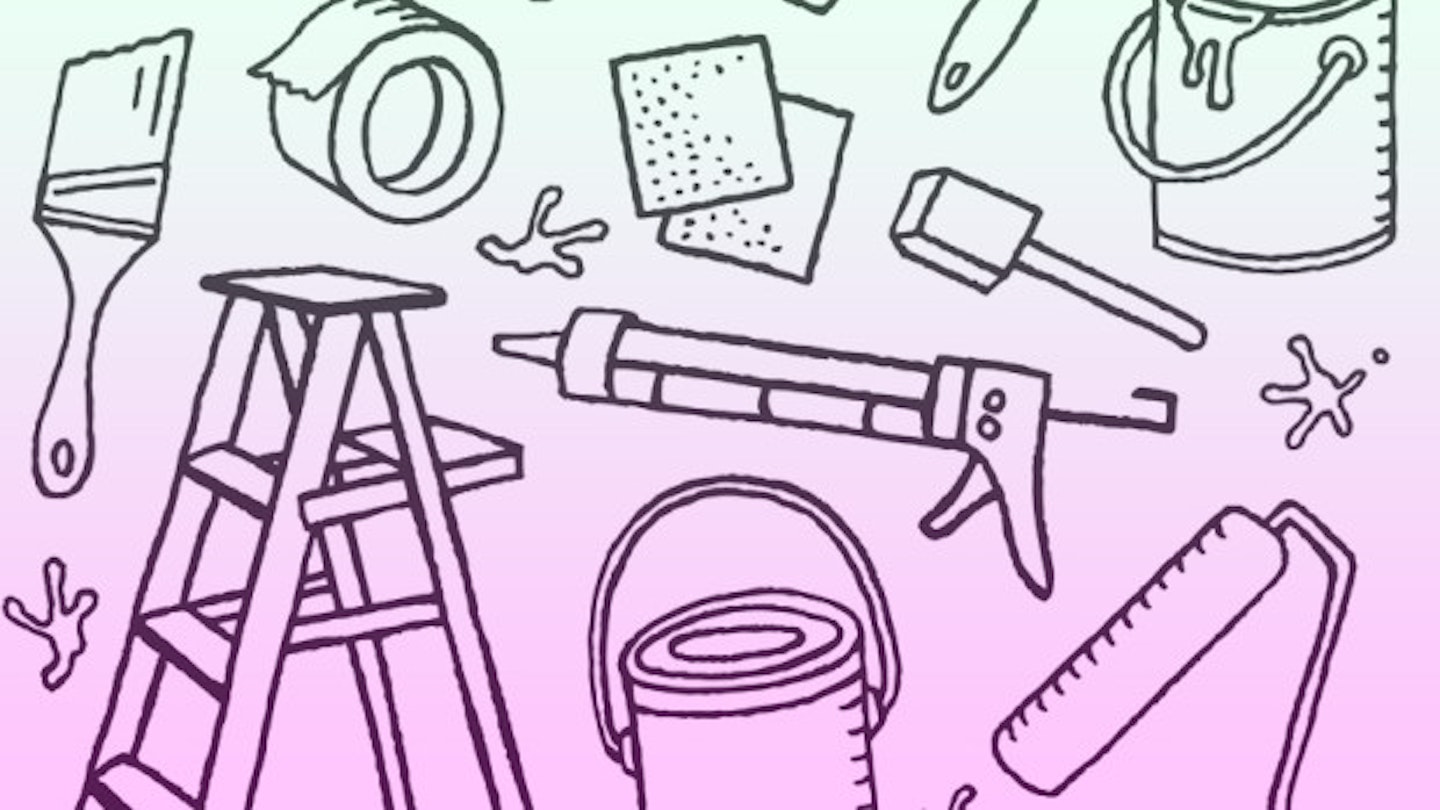C'mon ladies. There's no use standing there and screaming every time the toilet overflows. How come we're able to hold our own at work, out-manouvere boys on the dating field, but when it comes to a leaking tap we're absolutely stumped. We figured it was about time we all got a little schooling in the art of keeping your house from falling down. So we spoke to Jo Behari, DIY extraordinaire and the writer of T___he Girl's Guide to DIY_ for tips on a few simple DIY bits that you absolutely need to know how to do.

How to: change a plug
'Changing a plug is actually quite easy but it's worth investing in a good pair of wire cutters. This isn't actually a job you should need to do often but if you do have to do it you will need a flat head screwdriver, a cross head screwdriver and some wire cutters. Firstly you need to unscrew the big screws on the underside of the plug. near where the pins are. This will release the casing so that the two sides of the plug come apart. Inside you will see the thick wire come into the plug at the bottom and this splits into three separate wires which are connected to different terminals (the pins). If you push one of the pins out you will see copper wire fits through a hole in the terminal and is screwed down with a small screw. To remove the old wire unscrew these terminal screws and pull out the wire. Each terminal will have a symbol next to it outlining which wire is to go back in that place, so it will say earth, neutral or live. To fit a new plug thread the wires back through the plug in exactly the same order, you may need wire cutters here to neaten up the wires or to cut new sections of wire. It's important to ensure that the copper section is not coming out the other side of the terminal, and there isn't too much copper exposed on the wire side. Once you are happy all the wires are in the correct terminals screw the plug back together.'
How to: cover up the holes I made in my wall so my landlord won't notice
'The best way to do this is to buy either a pre-mixed filler or powdered filler which you can mix yourself. Clean the hole of any dust and push a small amount of filler into the hole using a fling knife (bit like a palette knife but smaller). Ensure the filler is slightly proud of the surface and leave it to dry according to the manufacturers instructions. Once dry, sand down with a mid-grade sandpaper (80grit). The problem with doing this in a rental property is you will need to know the colour of the paint on the walls to then paint over the filler and ensure you get your deposit back. It may be easy to use sticky fixings instead of nails.'
How to: get rid of that mould or damp that's slowly creeping up the wall
'Mould is normally a sign of a bigger problem so although you can get rid of it easily, it's occurrence shouldn't be totally ignored. To clean the mould you will need rubber gloves and sugar soap which comes in solution or powered form that you mix yourself. Prepare the sugar soap according to the instructions on the bottle and scrub the wall with the solution and a brush. Although it sounds sweet and harmless stage soap is actually very coarse and abrasive so wear gloves when you are working. Once you have cleaned the area, rinse it with warm water and leave to dry. Then try and figure out where the damp may be coming from. Things to consider are, is it seasonal, how long does it take to get bad, do you dry a lot of clothes on radiators, do you open windows regularly and is it only in one room or all over the house. All of these thing might be able to help you determine the cause and therefore the solution.'
How to: turn the lights back on when they've gone off (like they do every time you turn that bloody kettle on)
Well first of all, always have a torch handy and secondly ensure you know where your fuse box is located. A fuse box is now called a 'consumer unit' and is normally at the front of the property where mains electricity would enter. The job of the consumer unit is to split the mains electricity into different circuits and rings that power different things in your home. In a standard two storey house for example there would be an upstairs and downstairs lighting circuit and an upstairs and downstairs ring circuit (which powers the plug sockets). You may also have a few additional items on there such as a cooker or serrate kitchen ring. The little switches on the consumer unit are called MCB's (miniature circuit beakers) and essentially act like a light switch does. They stop electricity from reaching that circuit or ring. So if there is a particular problem in an area of the house and electricity is surging to that area the MCB will switch off which can cause all your lights to go out. A big surge will cause the mains switch on the consumer unit to shut off thereby stopping all electricity from travelling around your home. Normally this will happen if there has been a fault for example a light blows. When this happens and you don't have any electricity go tot he consumer unit and look at the big red switch, it will be in the off position. Flick back up to on and you should get the electricity back. If you don't there is a wider system failure and you need to contact an electrician. So my advice to you is whenever you move into a property ensure you know where the consumer unit is located.'
How to: unblock the toilet that is slowly reaching Def Con 5 in emergency toilet standards
'Once of the simplest ways to unblock a toilet is to create a vacuum using a plunger. You will need a specific toilet plunger for this as it will be bigger then a sink plunger. You can get one of these from most DIY stores. Position the plunger over the waste hole of the toilet ensuring it has a good touch on all sides of the bowl, plunge it up and down creating a vacuum of air which should push the blockage further down the pipes. If the water level in the bowl is quite high you might have better luck with a toilet snake which is not as scary as it sounds. Its a piece of cable with wire inside and an handle on the end, push the cable down right into the waste pipe and use the handle to turn the snake. This should break up any blockages allowing it to clear and the water to go down the pipe. If this is happening on a regular basis you might want a drain specialist to come and investigate the cause, they will often send a camera down the drain to check if there is anything major causing the blocks.'
How to: stop that bastard dripping tap that wakes me up at 4AM every morning
'A dripping tap is down to a perished washer. It can be easy to change and the parts are pennies, so worth doing yourself if you have the confidence. There are plenty of videos and guides online that can show you how to do this task. First things first though you need to shut off the water. You can do this either by turning off the isolation valve which should be located just under the tap on the water pipe. If you have one of these valves you will see a screw head on it that you can turn, once turned run the water and it should start to taper off and you know you have isolated water to this tap and you can work safely on it without causing a flood. The other way to isolate water is to turn the mains stopcock off. This may be located in your hallway or in your kitchen, somewhere where mains water enters the property. It's a tap connected to the outdoor mains water pipe and once you turn it water will no longer be able to enter the property. Turn on your taps and you should see the water starting to slow, but this may take longer then the isolation valve. You may not have isolation valves in your property so it's important to locate and test your stopcock as soon as you move into a new home. Its can save you a lot of damage if you do happen to have a leak.
To change the tap washer you need to dismantle the tap, normally there is a screw, cap or handle holding the outer casing together. This is different on all taps so just have a play around and see what loosens, or have a look on line at your specific tap and how to get the outer casing off. Once you have access to the inner parts of the tap you can remove this to reveal a tap washer at the bottom of the spindle. This is normally held in with a small screw or washer. if your tap has been dripping the washer will look perished and used which is why it is no longer creating a water tight seal. You can replace this with a standard tap washer purchased from any hardware store, but if you are uncertain take the old washer into the store with you to ensure you have bought the right thing. Resemble the tap and turn the water back on. A good tip is to take photos on your phone at every step so you can refer back to it when you are piecing everything back together. Also always work with the the plug in the sink drain so you don't loose any vital parts.'
Visit Jo's website here.
Follow Jess on Twitter @Jess_Commons
This article originally appeared on The Debrief.
